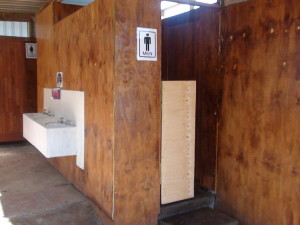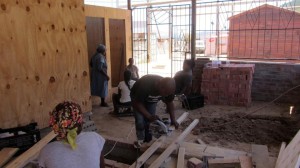By Thandeka Tshabalala on behalf of CORC
Langrug is an effervescent informal settlement that was illegally formed in 1993; this settlement is located in the most affluent farm area called Franschhoek, outside of Stellenbosch. Beyond the lavish hills and wine lands lies Langrug providing affordable housing to seasonal farm workers who work on the vineyards surrounding Stellenbosch. The settlement is characterised by extreme poverty, poor housing and sanitation. In spite of all these challenges, the community of Langrug have placed its hope on the partnership formed with the Municipality of Stellenbosch. It is through this innovative collaboration that forge the community’s inclusion and participation to shape a successful in situ upgrading process.
In November 2010, the SDI Alliance and Municipality introduced the partnership to the Mayor and Council. In 2011 a formal Memorandum of Understanding (MOU) was signed, clearly stating the joint objectives. The partnership aims at upgrading 7,000 households. This engagement aligns with the National Upgrading Support Program (NUSP) and the presidency-driven national programme delivery agreement to upgrade a total of 400,000 households by 2014. CORC has been helping the community of Langrug to participate in a comprehensive process of informal settlement upgrading.
Langrug’s Demographics
In March 2011 Langrug’s leadership created a dedicated profiling team to work side by side with its enumerators. The aim of the project was to map the settlement’s existing infrastructure by identifying on a scaled aerial photograph the location and conditions of all toilets, water taps, drains, drainage gullies, electricity boxes, and street lights. An enumeration was later conducted and it was found that the ratio of people to toilets was 49:1, and that of people to water points was 72: 1, with such services being sporadically dispersed through the settlement, access unequal, and service location inconsistent. Without a doubt, the need for an upgrade of sanitation facilities within the settlement was a priority.
The partnership with WPI
In 2011, two teams from Worcester Polytechnic Institute formed a partnership with the Langrug community with the hope of upgrading and maintaining the existing facilities and understanding the social interaction with these essential services. The project ultimately demonstrated how communities have the ability to interact with public infrastructure, and partner with planners to develop innovative means of providing more appropriate services.
The need for a grey-water project within Langrug was undeniably evident. Years of accumulated household grey water that was stagnating in the settlement resulted in numerous negative health effects for all settlement dwellers, and particularly for those living next to the water source, or for the children playing around it. A WPI grey-water team allied with community researchers with the aim of setting a precedent for community grey-water interventions, encouraging the community as a whole to participate in grey-water implementations and maintenance, develop grey-water systems that will service as sustainable long-term solutions, and equipping the co-researchers to continue aiding future grey-water projects.
In October 2012, through the upgrading partnership in Langrug, the community, CORC, Worcester Polytechnic Institute (WPI) and the Stellenbosch Municipality had an idea of an integrated community centre. The Initial idea of the project was to provide a multi-purpose Centre. Community hall, as a place for community gatherings, where groups can have a space to work, do business and learn. This would be complemented with a Water and Sanitation Hygiene area with unlimited use, for the whole community.
The idea was shared with the wider community and a site was proposed. The identified site was highly underutilized, it was overgrown with weeds and littered with solid waste. Two broken toilets stood on the space due to frequent vandalism. This site posed a growing health hazard for the Langrug Settlement, carrying the risk of transmittable disease, particularly to vulnerable groups such as children who often convert the space into a playground.
The wash facility
Even though the Municipality had been working to improve the ratio of toilets provided per household, but it was still far from South Africa’s standard of five families per toilet. The GE Foundation provided WPI with a grant to spend on an innovative, community-driven sanitation project. See http://wp.wpi.edu/capetown/homepage/projects/p2012/langrug/
The final wash design goes beyond the standard in sanitation by incorporating community-driven aspects with innovative sanitation services. The facility includes five hand-washing sinks, two of which are lowered for children, four laundry basins in a central area so mothers can watch their children while washing laundry, urinals, two showers, and a total of nine toilet stalls – three each for men and women, two for children, and one unisex handicapped stall. During operating hours, a caretaker responsible for cleaning, maintaining, and distributing toilet paper and soap monitors the facility. The wash facility is well lit and secured at night with the possibility of a toilet and tap to be accessible after hours. The facility is multifunctional and includes a children’s learning area, a hair salon and benches. These characteristics provide a more welcoming and dynamic communal space, an approach that has proven to increase the longevity and sense of community ownership of such a facility.
Technical design
The outer structure consists primarily of poles, timber and zinc sheets; these materials were chosen because they were easy to work with, obtainable at a relatively low cost, and were familiar to the community. The toilets, hand sinks, and laundry basins are made of a composite material that is both durable and aesthetically pleasing. The toilets use a push button design reducing the risk of vandalism by concealing the plumbing behind the walls. The facility has been designed with the intention of introducing sustainable sanitation options in the future such as:
- Rainwater collection for hand washing sinks
- Grey water collection and recycling for toilet flushing
- Urine divergent toilets
The Construction Process
The construction of the facility was a true multi-stakeholder process that all agreed had strengthened the Langrug partnership by bringing everyone together to work toward a common goal. Trevor and Alfred, Langrug community leaders, rose to the occasion and presented themselves as a key force throughout construction. Their building expertise and drive was inspirational and critical for the completion of the facility. A municipal field worker supported the working team every step of the way, especially with logistics and design recommendations. The CORC technical team was instrumental to the design process and to fostering effective working relationships.
Implementation challenges
Throughout the construction process, the team faced many challenges. During the second week of construction, farm worker riots prevented the team from reaching the build site for two full days, and when they could finally return to the site, they discovered that most of the building tools had been stolen. Though these obstacles challenged the construction process timeframe, everyone showed their resilience and pushed to keep the project moving forward.
The wash facility is currently fully functional and the community is using it to its full capacity. It operates between 6Am – 10Pm and the municipality of Stellenbosch has contracted two community members to clean and monitor the use of the facility. The community is glad with the development of the facility because they feel that it was a long awaited and needed facility, especially because it is not only limited to the community’s use, but football clubs also use it when they have come to play with the local teams and they are hoping that the local churches will use it when they are hosting religious festivals. This innovative structure is the beginning to a new and improved way of providing sanitation services to communities with a meaning and the community of Langrug is hoping that the municipality will implement more structures of this kind within the settlement.





